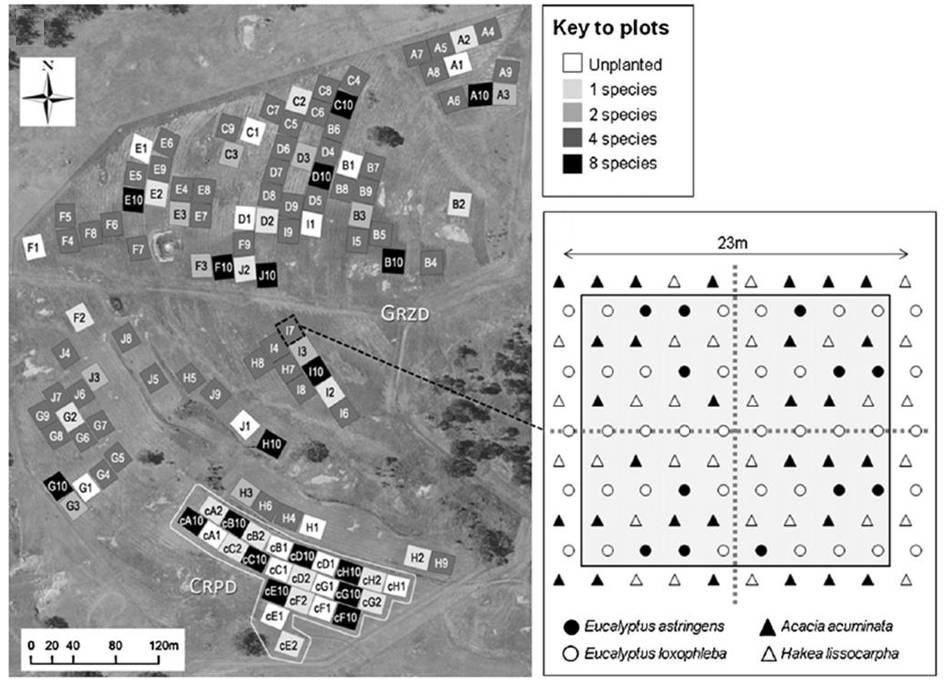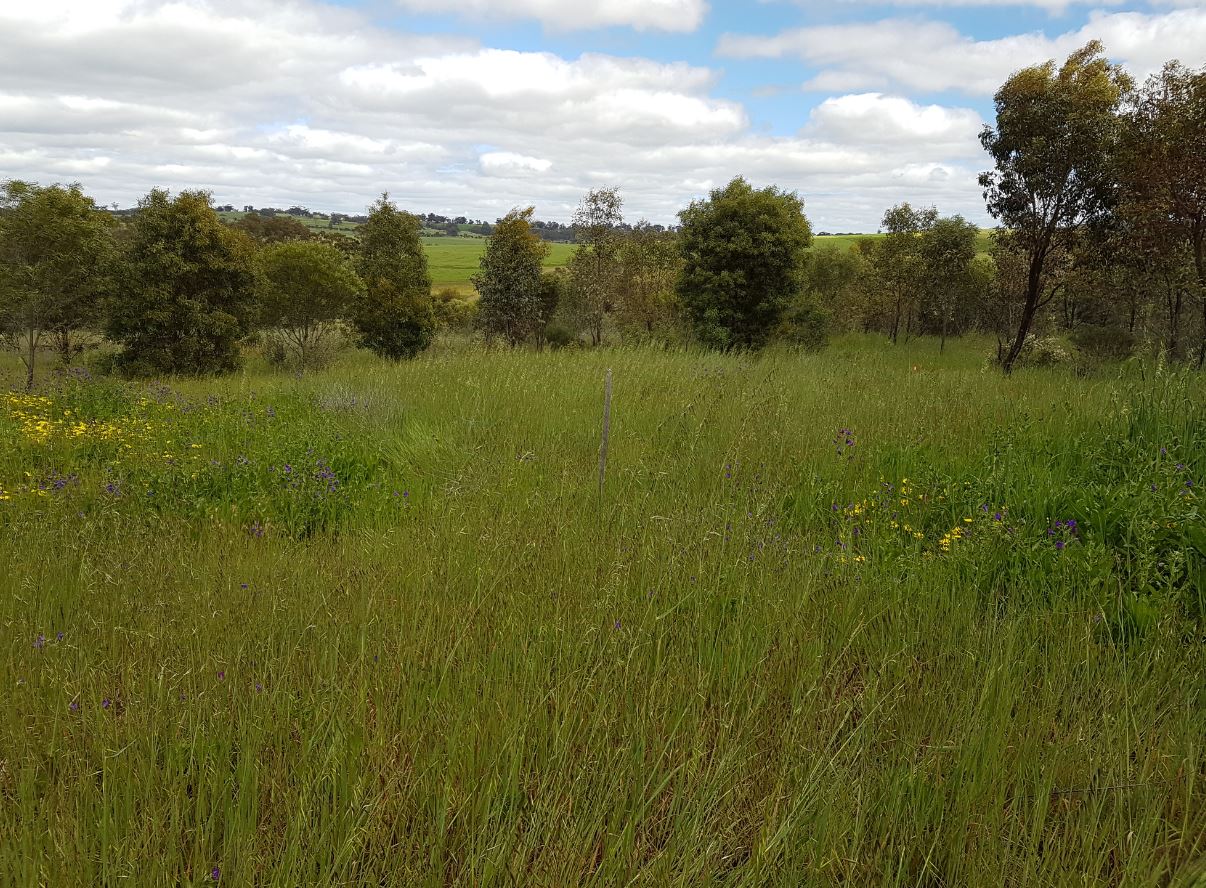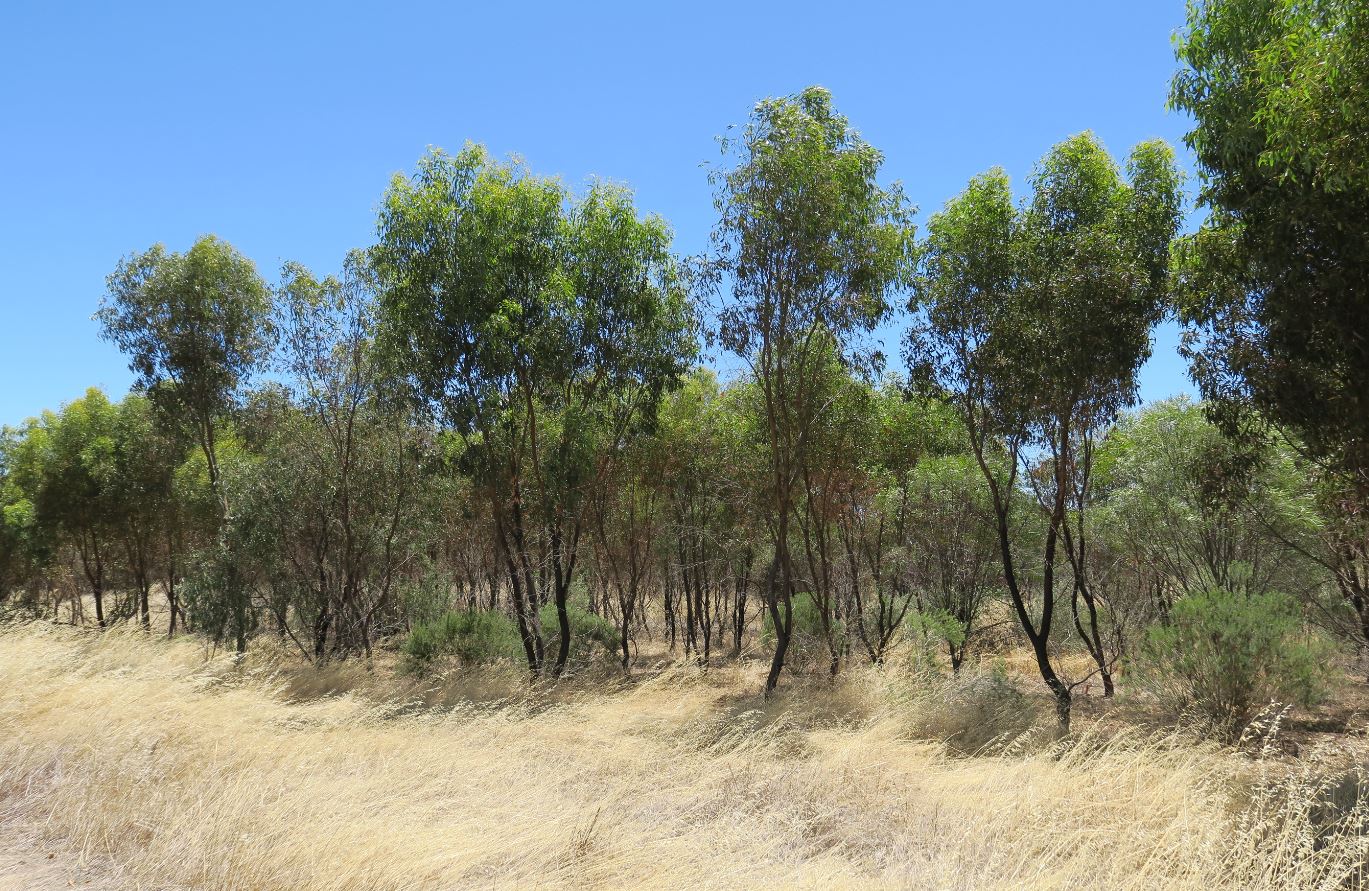Ridgefield (Australia)
The Ridgefield Multiple Ecosystem Services Experiment was established in 2010 to explore the provision of ecosystem services by different plant species in the context of restoration and global change in the wheat belt of south-western Australia. The focus of the experiment lies on a number of ecosystem attributes and processes, including those likely to be valued as services by land managers as well as the broader public.
Design
Ten different plant assemblage treatments are used in the plots. The treatments form a gradient of species richness, functional group richness, and structural complexity. Species were selected based on their nutrient acquisition traits and morphological traits such as growth form: trees, fabaceous shrubs, myrtaceous shrubs, and proteaceous shrubs. Unplanted plots were included to examine the changes that will occur in the absence of deliberate planting. The plots are blocked according to soil type, aspect, and soil moisture. Two environmental changes will be manipulated experimentally at the site: N deposition and non-native weed cover. Half of each plot is subjected to N deposition, with weed removal (by herbicide application) nested in quarter plots within these halves. Weed removal ceased in 2015; experimental nitrogen addition continued until August 2019. Generally, measurements took place on, or in the area enclosed by, the 16 individuals within each quarter plot. The species are arranged in a stratified random way in the plots, to maintain composition within each plot quarter. Shrubs and trees were planted on alternate rows c. 2 m apart, with 2.5 m between the individuals in the rows: 10 trees per line in each plot. The outer rows of a plot always have shrubs, apart from unplanted and tree-only plots. Border trees and shrubs were generally excluded from measurements but a whole experiment inventory was conducted in 2014”

Site characteristics
| Ridgefield (Australia) | |
|---|---|
| Country | Australia |
| Biome | Mediterranean |
| Latitude | -32.495376880000002 |
| Longitude | 116.9679077 |
| Soil type | Loamy sand to medium clay |
| Former land use | crops (24 plots), sheep pasture (100 plots) |
| Altitude | 350 m |
| Design | stem-wise randomisation, stratified by quarter and with ‘tree’ and ‘shrub’ riplines |
| Plot shape | square |
| Plot size (m^2) | 483 m² |
| Plant distance (m) | 2.5 (in rows), 2 (between) |
| Number of trees planted | 11 660 |
| Planting date | 14-16 August 2010 |
| Diversity gradient | 0, 1, 2, 4, 8 sp. 0, 1, 2, 3, 4 FD levels 0, 1, 2 growth forms |
| Size species pool | 8 |
| Species pool | Eucalyptus loxophleba Eucalyptus astringens Acacia acuminata Acacia microbotrya Banksia sessilis Callistemon phoeniceus Calothamnus quadrifidus Hakea lissocarpha |
| Contact person | Rachel Standish Mike Perring Sebastian Fiedler |
| r.standish@murdoch.edu.au mikper@ceh.ac.uk sebastian.fiedler@uni-goettingen.de |
Research
In the first stages of the experiment, studies will focus on C sequestration, biotic resistance, nutrient cycling, soil erosion control, biodiversity maintenance, and pollination.
Extra information
Send an e-mail to the contact persons, visit the experiment’s own website, or explore the publications that utilized data from this experiment.
PhD thesis
- Fiedler S 2021 Long-term Multifunctionality across Mediterranean-type ecosystems: Improving Restoration Outcomes through trait-based Modelling. PhD thesis, Freie Universität Berlin
- Yeeles P 2017 Mechanistic pathways of diversity-function relationships in Australian ants. PhD thesis, The University of Western Australia
- Garibello-Peña J 2016 Interactions of native seedlings with non-native plants for restoration in degraded ecosystems with Mediterranean climate. PhD thesis, The University of Western Australia
- Harrop-Archibald H 2015 The influence of litter quality, fungi and invertebrate decomposers on litter decomposition in a Mediterranean-climate ecosystem. PhD thesis, The University of Western Australia
- Johnson B 2015 Plant-pollinator networks in a restoration planting, and the effects of non-native plants and nitrogen fertilisation. PhD thesis, The University of Western Australia
Research papers
- Fiedler S, Perring MP, Monteiro JA, Branquinho C, Buzhdygan O, Cavieres LA, Cleland EE, Cortina‐Segarra J, Grünzweig JM, Holm JA, Irob K, Keenan TF, Köbel M, Maestre FT, Pagel J, Rodríguez-Ramírez N, Ruiz-Benito P, Schurr FM, Sheffer E, Valencia E, Tietjen B 2025 Trade-offs among restored ecosystem functions are context-dependent in Mediterranean-type regions 2025(8): e07609 - doi.org/10.1002/ecog.07609
- Yeeles P, Lach L, Hobbs RJ, Didham RK 2025 Functional redundancy compensates for decline of dominant ant species. Nature Ecology and Evolution 9: 779-788 - doi.org/10.1038/s41559-025-02690-y
- Blondeel H, Guillemot J, Martin‐StPaul N, Druel A, Bilodeau‐Gauthier S, Bauhus J, … Baeten L 2024 Tree diversity reduces variability in sapling survival under drought. Journal of Ecology 112(5): 1164-1180 - https://doi.org/10.1111/1365-2745.14294
- Luo S, Schmid B, Hector A, Scherer‐Lorenzen M, Verheyen K, Barsoum N, Bauhus J, Beyer F, Bruelheide H, Ferlian O, Godbold D, Hall JS, Hajek P, Huang Y, Hölscher D, Kreft H, Liu X, Messier C, Nock C, Paquette A, Parker JD, Parker WC, Paterno GB, Reich PB, Rewald B, Sandén H, Sinacore K, Stefanski A, Willams L, Eisenhauer N 2024 Mycorrhizal associations modify tree diversity− productivity relationships across experimental tree plantations. New Phytologist 243:1205-1219 - doi: 10.1111/nph.19889
- Zheng L, Barry KE, Guerrero-Ramírez NR, Craven D, Reich PB, Verheyen K, … Hautier Y 2024 Effects of plant diversity on productivity strengthen over time due to trait-dependent shifts in species overyielding. Nature communications 15(1): 2078 - https://doi.org/10.1038/s41467-024-46355-z
- Depauw L, De Lombaerde E, Dhiedt E, Blondeel H, Abdala-Roberts L, Auge H, Barsoum N, Bauhus J, Chu C, Damtew A, Eisenhauer N, V. Fagundes M, Ganade G, Gendreau-Berthiaume B, Godbold D, Gravel D, Guillemot J, Hajek P, Hector A, Hérault B, Jactel H, Koricheva J, Kreft H, Liu X, Mereu S, Messier C, Muys B, Nock CA, Paquette A, Parker JD, Parker WC, Paterno, GB, Perring MP, Ponette Q, Potvin C, Reich PB, Rewald B, Scherer-Lorenzen M, Schnabel F, Sousa-Silva R, Weih M, Clara Zemp D, Verheyen K, Baeten L 2024 Enhancing Tree Performance Through Species Mixing: Review of a Quarter-Century of TreeDivNet Experiments Reveals Research Gaps and Practical Insights. Current Forestry Reports - https://doi.org/10.1007/s40725-023-00208-y
- FAO 2023 Towards more resilient and diverse planted forests. Unasylva (254)74: 2031/1. Rome. https://doi. org/10.4060/cc8584en
- Fiedler S, Monteiro JAF, Hulvey KB, Standish RJ, Perring MP, Tietjen B 2021 Global change shifts trade-off among ecosystem functions in woodlands restored for multifunctionality. Journal of Applied Ecology 58(8): 1705-1717 - https://doi.org/10.1111/1365-2664.13900
- Messier C, Bauhus J, Sousa-Silva R, Auge H, Baeten L, Barsoum N, Bruelheide H, Caldwell B, Cavender-Bares J, Dhiedt E, Eisenhauer N, Ganade G, Gravel D, Guillemot J, Hall JS, Hector A, Hérault B, Jactel H, Koricheva J, Kreft H, Mereu S, Muys B, Nock CA, Paquette A, Parker JD, Perring MP, Ponette Q, Potvin C, Reich PB, Scherer-Lorenzen M, Schnabel F, Verheyen K, Weih M, Wollni M, Zemp DC 2021 For the sake of resilience and multifunctionality, let’s diversify planted forests! Conservation Letters e12829 - https://doi.org/10.1111/conl.12829
- Fiedler S, Perring MP, Tietjen B 2018 Integrating trait-based empirical and modeling research to improve ecological restoration. Ecology & Evolution 8: 6369-6380 - doi: 10.1002/ece3.4043
- Yeeles P, Lach L, Hobbs RJ, Van Wees M, Didham RK 2017 Woody plant richness does not influence invertebrate community reassembly trajectories in a tree diversity experiment. Ecology 98: 500-511 - doi: 10.1002/ecy.1662
- Harrop-Archibald H, Didham R, Standish R, Tibbett M, Hobbs R 2016 Mechanisms linking fungal conditioning of leaf litter to detritivore feeding activity Soil Biology and Biochemistry 93: 119-130 - doi: 10.1016/j.soilbio.2015.10.021
- Perring MP, Standish RJ, Hulvey KB, Lach L, Morald TK, Parsons R, Didham RK, Hobbs RJ 2012 The Ridgefield Multiple Ecosystem Services Experiment: Can restoration of former agricultural land achieve multiple outcomes? Agriculture, Ecosystems and Environment 163: 14-27 - doi:10.1016/j.agee.2012.02.016


The Ridgefield Multiple Ecosystem Services Experiment in 2012 and 2013


The Ridgefield Experiment in spring 2016 (Bec Campbell) and in 2018 (R. Hobbs)